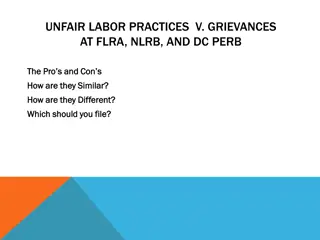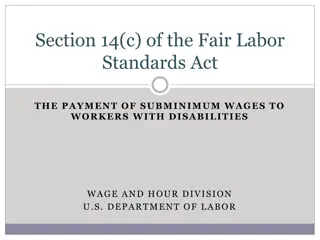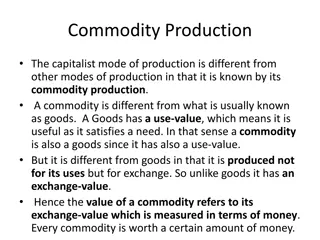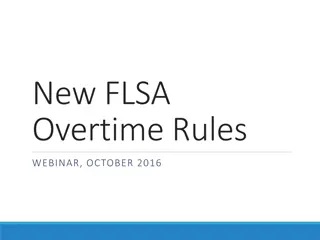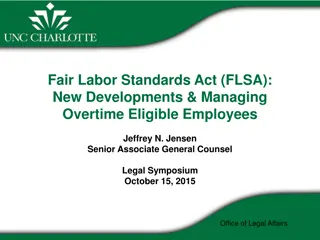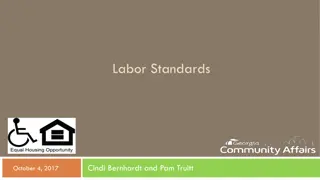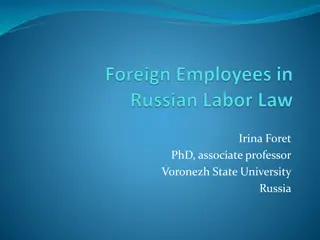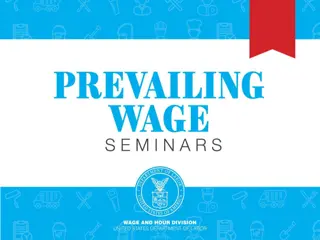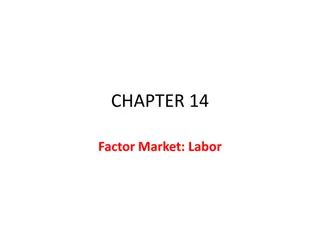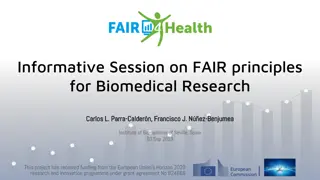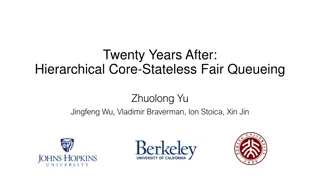Understanding the Fair Labor Standards Act (FLSA)
The Fair Labor Standards Act (FLSA) was signed into law in 1938 by President Franklin D. Roosevelt to address child labor, establish minimum wage, and regulate work hours. It sets standards for minimum wage, overtime pay, recordkeeping, and youth employment, impacting both private and government sectors. Nonexempt employees must be paid minimum wage and overtime rates, and recent changes aim to increase the minimum wage for workers. Compliance with FLSA is crucial for all employees to avoid negative consequences.
Download Presentation

Please find below an Image/Link to download the presentation.
The content on the website is provided AS IS for your information and personal use only. It may not be sold, licensed, or shared on other websites without obtaining consent from the author. Download presentation by click this link. If you encounter any issues during the download, it is possible that the publisher has removed the file from their server.
E N D
Presentation Transcript
Fair Labor Standards Act: What You Need to Know Jeffrey N. Jensen Senior Associate General Counsel Legal Symposium October 16, 2014 Office of Legal Affairs
Opening Questions 1. Should all University employees understand the basics of the Fair Labor Standards Act (FLSA)? 2. Are there negative consequences if we fail to comply with the FLSA? 3. Are there regulatory changes on the horizon that could result in some University employees being reclassified so they become eligible for overtime under the FLSA?
HISTORY OF THE FLSA President Franklin D. Roosevelt signed the Fair Labor Standards Act into law in 1938. In its initial form, the FLSA applied only to about 20% of the country s industrial employers. It banned oppressive child labor, set the minimum hourly wage at 25 cents, and the maximum workweek at 44 hours.
ORIGINAL PURPOSE FDR signed the FLSA in 1938 to end starvation wages and intolerable hours. FDR S three goals - End child labor abuses Establish a minimum wage Cap the number of work hours per week
TODAYS FAIR LABOR STANDARDS ACT Establishes minimum wage, overtime pay, recordkeeping, and youth employment standards affecting full-time and part- time workers in the private sector and in Federal, State, and local governments. The U.S. Department of Labor s Wage and Hour Division administers and enforces the FLSA with respect to private employment and State and local government employment.
WAGE & HOUR LAWS BASIC TENETS Minimum wage One and one-half times regular hourly rate of pay for all hours worked over 40 Employers must pay all nonexempt employees at least the minimum wage for all hours worked, and at lease one and one-half times their regular hourly rate of pay for all hours worked over 40 in a singe week.
MINIMUM WAGE Since July 24, 2009, covered, nonexempt workers are entitled to a minimum wage of not less than $7.25 per hour. In April of 2014, Senate s Minimum Wage Fairness Act would have increased the minimum wage to $10.10 per hour. Last week DOL published a rule that requires federal contractors to pay at least $10.10 per hour beginning in January 2015.
COMPENSEATION TIME IN LIEU OF OVERTIME PAY Tool available to public sector employers Maximum accrual limit under law/policy Employee must have a reasonable opportunity to use comp time When must the employer pay out?
COMPENSATION TIME 1. Public sector employers may provide comp time in lieu of overtime pay as long as there is an understanding prior to the performance of the work in question. 2. Public sector nonexempt employees in North Carolina may accrue up to 240 hours of comp time (160 hours straight time). Any overtime worked above this amount shall be paid in the employee s next regular paycheck.
COMPENSATION TIME 3. An employer must honor requests to use comp time within a reasonable period of time, as long as the time off does not unduly disrupt operations. 4. Pursuant to North Carolina policy, the University should allow overtime compensation to be taken as soon as possible.
COMPENSATION TIME 5. Pursuant to North Carolina policy, nonexempt employees shall take their compensatory leave within twelve months from the date the work was performed. 6. Moreover, if comp time is not taken within 365 days, the time shall be paid out in the employee s next paycheck.
EXEMPT or NONEXEMPT Employees whose jobs are governed by the FLSA are either exempt or nonexempt. Nonexempt employees are entitled to overtime pay. Exempt employees are not.
Which employees are exempt? With few exceptions, to be exempt an employee must (a) be paid at least $455 per week ($23,600 per year), and (b) be paid on a salary basis, and also (c) perform exempt job duties. Most employees must meet all three tests to be exempt.
The White Collar Exemptions The most well-known and commonly used of the dozens of FLSA exemptions are the so-called white collar exemptions for three categories of employees: Executive Administrative, and Professional.
Test #1 Salary Level Test must be paid a minimum of $455/week ($23,600/year) employees paid less are nonexempt
Test #2 Salary Basis Test An exempt employee is paid on a salary basis For any week in which work is performed Employee receives a fixed, guaranteed amount of pay Pay not subject to reduction regardless of the quality or quantity of work, or of the hours worked
Test #3 Duties Tests by Job Category Executive Administrative Professional: Learned and Creative There are typical job duties for each of these white collar categories.
EXECUTIVE EXEMPTION Primary duty of managing the enterprise, department or division Regularly directs two or more employees Must possess the authority to hire, fire, or otherwise affect the status of other employees or to recommend such action
ADMINISTRATIVE EXEMPTION Primary duty of non-manual or office work Directly related to the management or general business operations of the employer or the employer s customers (i.e., the University s students) Primary duty includes the exercise of discretion and independent judgment with respect to matters of significance
PROFESSIONAL EXEMPTION Learned Professional Primary duty is performing work that requires advanced knowledge in a field of science or learning, customarily acquired by a prolonged course of specialized intellectual instruction Work requires consistent exercise of discretion and judgment Fields of science or learning from which degreed professionals qualify for this exemption: accounting, engineering, medicine, law architecture, teaching, etc.
PROFESSIONAL EXEMPTION Creative Professional Primary duty requires invention, imagination, originality, or talent in a recognized field of artistic or creative endeavor Work requires consistent exercise of discretion and judgment
To review Most employees must meet all three tests to be exempt. With few exceptions, to be exempt an employee must: (a) be paid at least $455 per week ($23,600/year), and (b) be paid on a salary basis, and also (c) perform exempt job duties.
Highly Compensated Employee Exemption Established pursuant to the FairPay Amendments of 2004 regarding the white collar exemptions under the FLSA. Employee paid $100,000 or more will be considered exempt from overtime if has one identifiable white collar duty that is customarily and regularly performed.
RECORDKEEPING The FLSA requires employers to keep accurate time records for all nonexempt employees. Federal law does not require any particular method of record keeping. A method which requires nonexempt employees to clock in or write in their own time, or at least sign off on their time is strongly preferred, as this limits the employees ability to later say the time recorded is not accurate. Records of hours worked must be preserved for at least three years.
How do we count hours worked? As the FLSA does not prescribe a method, an employer can use: a time clock manual time sheets, or computerized timekeeping tool Most nonexempt employees at UNC Charlotte are required to fill out weekly time sheets that are signed by their supervisor. A computerized timekeeping tool is being piloted on campus.
Time Clocks & Computerized Timekeeping Many employers utilize time clocks and computerized timekeeping systems, in an effort to increase efficiency, decrease cost, and eliminate some of the human error that goes along with time keeping. Caution: No system is foolproof! U.S. Department of Labor can factor in work time not reflected on an employee s official time records, if there is evidence work is being performed but not recorded.
Calculating Arrival and Departure Times Issues might arise during transition from time sheet to computer timekeeping system DOL allows use of 7-minute rule Must pay if nonexempt employee regularly clocks in more than 7 minutes early Establish clear punch-in and punch-out policy and expectations
Meal Periods A meal period of at least 30 consecutive minutes (never less) during which a nonexempt employee is completely relieved of duty and free to use the time for her/his own purposes. It is not counted as hours worked or paid time. Any so-called meal period of less than 30 consecutive minutes must be paid as hours worked.
Meal Periods Q. If an employee is merely asked to sit by a telephone during lunch, is that passive activity compensable? A. Yes, the employee is not relieved of duty if he or she is required to perform any duties, including passive activities such as sitting by a phone. Employees who volunteer to work through meal breaks should either be prohibited from doing so or paid for their time. Otherwise, you may end up with claims for unpaid wages and overtime.
Rest Periods Although the FLSA does not require that employees receive rest periods, University supervisors have the discretion to permit a rest period of up to 15 minutes during each four-hour period of work. Rest periods are compensable time.
Training Time spend at a conference, meeting or seminar is compensable if: 1. Attendance is during normal work hours; 2. Attendance is required by the university; 3. Event is directly job-related; or 4. University work is performed Note: Meal breaks, sleeping, and voluntary social events that are part of a training event are not compensable work time.
Travel by Nonexempt Employees All travel time within a single day is compensable work time. Overnight travel not compensable if: Outside of normal working hours (not working days) Employee does not drive Employee does not work while traveling
Nursing Mothers Breaks The Patient Protection and Affordable Care Act (PPACA) amended the FLSA in March of 2010: to require employers to grant reasonable breaks for an employee to express breast milk for up to one year after giving birth, and to provide a private location (other than a bathroom) for the employee to do so. See UNCC s Lactation Policy, UP 101.20
Email, Texting & Twitter as working time? Q. If nonexempt employees are using electronic devices to receive and reply to work-related messages during nonworking hours, is that time compensable under the FLSA? A. It depends. Best Practice - Supervisor should establish a clear expectation, preferably advising all nonexempt employees to not use their home computer, laptop, smartphone, PDA or tablet to perform work outside of working hours or during their unpaid meal breaks.
Email, Texting & Twitter as working time? Best Practice - Supervisors should be careful not to encourage nonexempt employees to check or respond to work-related emails during nonworking hours. Best Practice - If such work is permitted or expected, however, supervisors should carefully manage and record all such work by requiring nonexempt employees to record all time spent checking, sending, or receiving work- related emails, and then compensate the employee for that time. In the spring of 2011, the U.S. Department of Labor launched DOL Timesheet, a free application for smart phone with an easy-to-use electronic timesheet.
De Minimus Doctrine FLSA s general rule is that all work is compensable. The de minimus doctrine permits employers to treat very small increments of time as non-compensable (e.g., 10 minutes or less). This means that if an nonexempt employee occasionally works for a few minutes off the clock either at home or before clocking in at work, the employer does not need to track this time.
Email, Texting & Twitter as working time? 1. Use 10-minute (de minimus) rule as guideline 2. Consider regularity and aggregate amount of time spent 3. Establish clear expectations regarding use of electronic devices outside of normal work hours 4. When possible, prohibit nonexempt employees from using electronic devices to work outside of their normal business hours 5. Be prepared to record and pay for compensable working time
FLSA Enforcement Mechanisms Wage and Hour Division investigations and lawsuits Private lawsuits To enforce the minimum wage and overtime provisions of the FLSA, the U.S. Department of Labor s Wage and Hour Division (WHD) has the authority to investigate and gather data from employers regarding wage, hours, and other conditions and practices of employment; to enter and inspect an employer s place of business and its records; to question employees; and to investigate all facts, conditions, practices and matters the investigator deems necessary to determine whether the FLSA has been violated.
Wage and Hour Division (WHD) Enforcement Recent increase in enforcement activity since 2009 WHD has hired 40% more investigators and annually completed 40% more compliance actions A WHD investigation can be trigged by a complaint of an employee or a former employee WHD may commence a lawsuit on behalf of impacted employees seeking: unpaid minimum wages, overtime, liquidated damages (equal to the unpaid wages), and injunctive relief
Private Lawsuits Under the FLSA An employee may sue an employer for violating the FLSA s minimum wage or overtime provisions Private lawsuits to enforce non-willful violations of the FLSA must be brought within two years whereas the limitation period for willful violations is three years The damages available to employees in FLSA actions are potentially huge
Why are FLSA claims potentially so expensive? Available civil remedies include: 1. All unpaid compensation for time worked but not paid, or time paid at an incorrect amount Mandatory liquidated damages (equal to the amount of unpaid compensation) that effectively doubles unpaid wages for a period of up to three years back (for willful violations, two years for non-willful) Interest Attorneys fees 2. 3. 4.
Why are FLSA claims potentially so expensive? Collective Actions Multiply the total exposure for one employee by the total number of similarly-situated employees Recent collective FLSA actions have concerned: Misclassification of workers Working on work-related matters during non-work time Deducting time for breaks without ensuring that employees were not, in fact, working
Obama Administration Proposal to Narrow White Collar Exemptions Goal = Narrow exemptions so more workers qualify for overtime pay by raising salary threshold level and changing the primary duties test The salary threshold has been changed only eight times in the 75 years since the FLSA passed in 1938. In 1975, the weekly salary threshold was set at $155/week and in 2004 it was raised to $455/week. The Obama Administration proposes adjusting the threshold for inflation since 1975, thereby raising the salary level to $970/week ($50,440/year).
Obama Administration Proposal to Narrow White Collar Exemptions New FLSA rule may also require performance of a minimum percent of executive work before an employee can be exempted from qualifying for overtime pay. For example, in California the duties test for white-collar exempt employees requires exempt employees to spend more than half their time engaged in exempt work. If less, they would be classified as nonexempt.
Obama Administration Proposal to Narrow White Collar Exemptions There are approximately 400 UNC Charlotte employees who earn at or below the $50,000 annually, the proposed new salary level, who are currently classified as exempt from the FLSA. There are University employees in the executive White Collar exemption category who may not spend at least 50% of their time on exempt work. Under the new rule, they may need to be reclassified as nonexempt. Bottom Line - The proposed new FLSA regulations could require the University to reclassify dozens of employees as nonexempt, making them eligible to earn comp time for all overtime hours they work.
Self-Audit The best way for an employer to be prepared for a DOL audit or investigation is to conduct periodic reviews or self-audits. As DOL audits focus on record-keeping, overtime pay, and ensuring that all employees are being paid for hours worked, a self-audit should ensure compliance with these targeted areas.
Issue #1 Exempt v. Nonexempt Classifications It is wise to audit the exempt classifications of the workforce periodically to ensure that employees are properly classified as exempt or nonexempt. Remember that the job duties attached to a particular position may change over the years, and a position that was exempt ten years ago may no longer be exempt today. Realistically analyze the actual duties performed by the employee to determine whether the employee is properly classified as exempt. Carefully consider what the employee actually does on a daily basis. If appropriate, modify the job title or revise the job description to reflect changes of job duties.
Issue #2 Close Calls During a self-audit, employer should be especially wary of any close cases. The employer has the burden to prove an exemption applies. Just because an employer could treat a position as exempt, doesn t mean it is required to do so. Paying a nonexempt employee overtime pay may be the least risky approach in some difficult classification cases.
Issue #3 Supervisors Before determining that an employee falls within the executive exemption, ensure that the employee has actual supervisory duties and management is her/his primary duty.
Issue #4 Power to Hire or Fire To fall within the executive exemption, the employee must have actual authority to hire or fire or to have his/her suggestions given particular weight. Consider whether the person has ever been involved in the hiring or firing of any employee. If not, then the employer may want to reevaluate the employee s exempt status.





